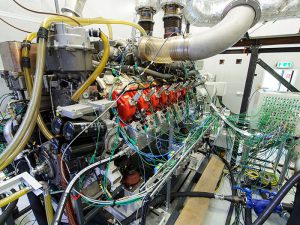
MTU marine gas engine completes 3,000 hours testing
JULY 7, 2016 —Rolls-Royce Power Systems AG reports that the new MTU marine gas engine has successfully completed 3,000 hours on the test bed and is on track to go into series

JULY 7, 2016 —Rolls-Royce Power Systems AG reports that the new MTU marine gas engine has successfully completed 3,000 hours on the test bed and is on track to go into series
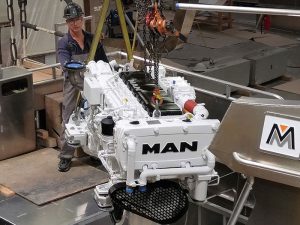
JUNE 29, 2016 — The first MAN D2676 engine for work boats will soon be at work fishing for salmon in Alaska’s Bristol Bay. MAN Engines introduced its latest generation of in-line
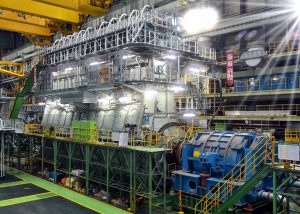
JUNE 24, 2016 — The largest and most powerful engine ever from MAN Diesel & Turbo has entered service. Built by Doosan Engine in Korea and rated at 75,570 kW (103,000 horsepower),
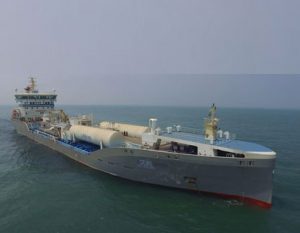
JUNE 23, 2016 —The first dual-fuel two-stroke engine using the low-pressure X-DF gas admission technology developed by Winterthur Gas & Diesel (WinGD) has passed the final milestone in its passage from a
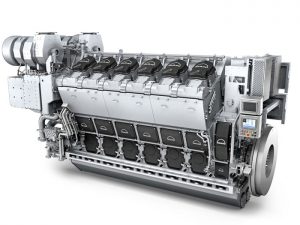
MARCH 11, 2016 — Japan’s JFE Engineering Corporation has entered a new cooperation agreement with MAN Diesel & Turbo. It covers the manufacture of MAN 32/44CR, 35/44DF, 48/60CR and 51/60DF four-stroke engines
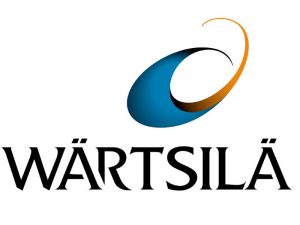
MARCH 7, 2016 — A Wärtsilä Corporation internal audit of test processes has uncovered “deviations” in some fuel consumption measurement tests conducted on marine engines in Wärtsilä Delivery Center,Trieste, Italy before customer
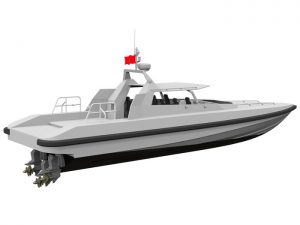
They will be used to combat illegal activities such as terrorism and smuggling in Moroccan waters.
Designed for ultra-fast operations, the Interceptor 1503 can reach speeds of up to 60 knots, thanks to combining an outstanding propulsion system —powered by three MDS (Marine Diesel Sweden) VG-32 diesels — with cutting edge lightweight composite materials.
Each diesel drives a separate stern drive. The hull is constructed from fiber reinforced plastic in an epoxy resin matrix – renowned for its resistance to impact and fatigue as well as its lightweight properties.
Well suited for tracking down and taking appropriate action on illegal activities, the highly maneuverable Interceptors also have additional space in the cockpit for search and rescue survivors.
As international security concerns have heightened, Damen has seen growing interest in its range of Interceptor vessels. In response, it is continuing to invest in a substantial Research and Development program to design and build safe, strong and ultra-fast composite vessels.
Although the Interceptor has been in Damen’s portfolio for some time, the five vessels in this latest ordervwill be the first in a new series of reengineered vessels.
All five Interceptor 1503 vessels will be constructed at Damen’s state-of-the-art shipyard specializing in composite vessel construction in Antalaya, Turkey.
The first vessel will be delivered in June 2016, followed thereafter by one vessel every six weeks
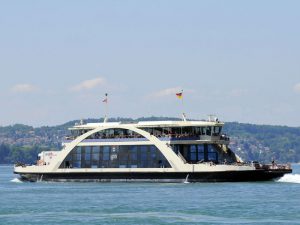
The intention is to have the new member of the fleet operated by the public utility running on gas between the two Lake Constance (the Bodensee) towns of Konstanz and Meersburg in 2019.
The new ferry will be one of the first in Europe to be powered by a high-speed pure-gas engine. It will feature low pollutant emissions and improved cost effectiveness, while delivering the accustomed high performance.
MTU is to develop the new 8-cylinder gas engine with a rated output of 750 kW based on the proven MTU Series 4000 diesel engines for workboats. The clean combustion concept will make it possible to meet IMO Tier III emission standards without the need for additional exhaust aftertreatment. By comparison with a diesel engine without exhaust aftertreatment, the gas engine will emit no soot particles and no sulfur oxides, 90 percent less NOx and 10 percent less greenhouse gas.
The new 8V 4000 gas engine will incorporate gas injection for individual cylinders, a dynamic engine control system and a safety concept optimized for natural gas operation.
The new gas engine series is being developed to ensure that it meets the particular load profile of the Lake Constance ferries, with acceleration comparable to that of the MTU diesel engines.In the development of the 8V 4000 engine, MTU benefits from its previous experience in stationary gas engines and from development work now being carried out for a 16-cylinder marine gas engine, which is currently underway and has just completed initial tests on the test bench. The first pre-series engines will power a tugboat in 2017, which is currently being built by Damen shipyards for Svitzer.
The MTU brand is part of Rolls-Royce Power Systems within the Land & Sea division of Rolls-Royce.
The Rolls-Royce Group, of which Rolls-Royce Power Systems is a member, has almost ten years’ experience in delivering medium-speed, pure-gas propulsion systems to power ferries.
“We are delighted that MTU, our partner of many years standing, is developing a natural gas propulsion system for our new ferry,” said Dr. Norbert Reuter, Managing Director of Stadtwerke Konstanz GmbH. “The deciding factors for us to venture into a new world of propulsion for our fleet are the excellent environmental compatibility of the gas engines and the possibility of saving fuel costs, while maintaining our current requirements in terms of the performance and maneuverability of the vessel. As a ferry operator on Lake Constance, Europe’s largest reservoir of drinking water, it is very important for us to guarantee safe and environmentally sound operations.”
“We are convinced that gas engines will become increasingly important as supplements to tried and tested diesel engines for shipping,” said Marcus A. Wassenberg, Chief Financial Officer at Rolls-Royce Power Systems AG. “Natural gas is an important fuel for the future. It will be available for a longer period of time and is cheaper in many regions throughout the world, in addition to having a far better carbon footprint than either heavy oil or diesel. With the development of the new gas engine and its trials in the ferry operated by Stadtwerke Konstanz, we are taking up the challenge of further improving the emissions and efficiency levels of gas engines, in order to be able to meet future emission regulations and the needs of our customers. The development of gas engine technology and the associated fuel infrastructure will also require state funding until they become economically viable.”
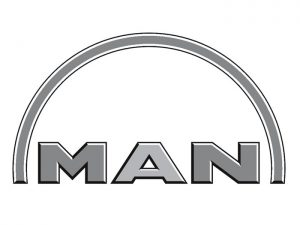
NOVEMBER 19, 2015 — MAN Diesel & Turbo Sverige AB, a wholly owned subsidiary of MAN Diesel & Turbo SE (part of MAN and Volkswagen Group), is acquiring the marine fuel gas
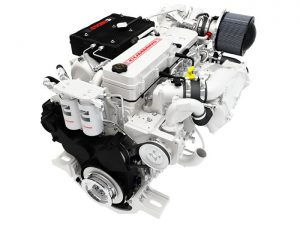
Since the £8.5 million plant began engine production in 1965, with over 400 employees onsite, around 1.5 million engines have been built in the factory for customers worldwide.
Production began with the assembly of Cummins VAL and VALE range of Small Vee V6 and V8 engines. With capacities of 352 and 504 cu in (5.7 and 8.3 liters) they had an output of up to 150 hp (111 kW), suitable for a range of boats at the time.
The Small Vee engines proved popular in the marine market and in 1966 the British offshore power boat Merry-Go-Round, with twin Cummins, broke the world water speed record for diesel power at over 60 mph. The record was achieved off the UK coast on Southampton Water. The two VT8 racing engines were each rated at 520 hp (387 kW), especially for the event.
“The Small Vee was an evolutionary design at the time with some of the key features of the original engine carrying on into current products – such as an efficient high pressure fuel system, cylinder heads with four valves per cylinder, a rear gear train configuration, a high power to weight ratio, and major components with the latest materials designed for durability and reliability,” said Michel Kozulic, Marine Business Development Manager.
In 1986 a major upgrade saw the Darlington plant shift production to the B Series engine. The 5.9 liter displacement engine was the forerunner of the latest 6.7 liter unit produced today.
The current QSB6.7, built at the Darlington plant, offers the latest engine technology providing between 230 and 550 hp (172-410 kW), and up to 1,695 Nm in torque in an inline 6 cylinder configuration.
Exceptional performance driven through a perfectly matched Cummins wastegated turbocharger and a new 24 valve cylinder head delivers industry leading power density. The engine has a quiet operation, including an 80 percent reduction in noise at idle. It is also possible to maximize vessel performance and access comprehensive vessel diagnostic information via SmartCraft electronics.
The QSB6.7 engine provides propulsion and power generation to many motor boats, and has recently featured in the Princess 43. A brand new SL option package is now available for the QSB6.7, offering a lighter and more compact engine, allowing easy installation into the vessel.
Tim Hamilton, Marine Product Engineer said, “Working at Cummins Darlington for over 30 years, I have seen a dedication to innovation, product development and build quality. We have always worked closely with our customers to ensure we have the right product for them and to ensure the best level of service and integration in the vessel.”
The Darlington factory now employs over 800 people and has a dedicated marine engine area onsite, a separate product development center and a neighboring plant producing exhaust aftertreatment systems. £10.4 million has recently been invested into production and development at Darlington, supported by a regional growth fund grant. Marine engines from 6.7 to 11 liters (230-715 hp / 171-533 kW) are available from the Darlington site, including a range of helm to propeller packages.